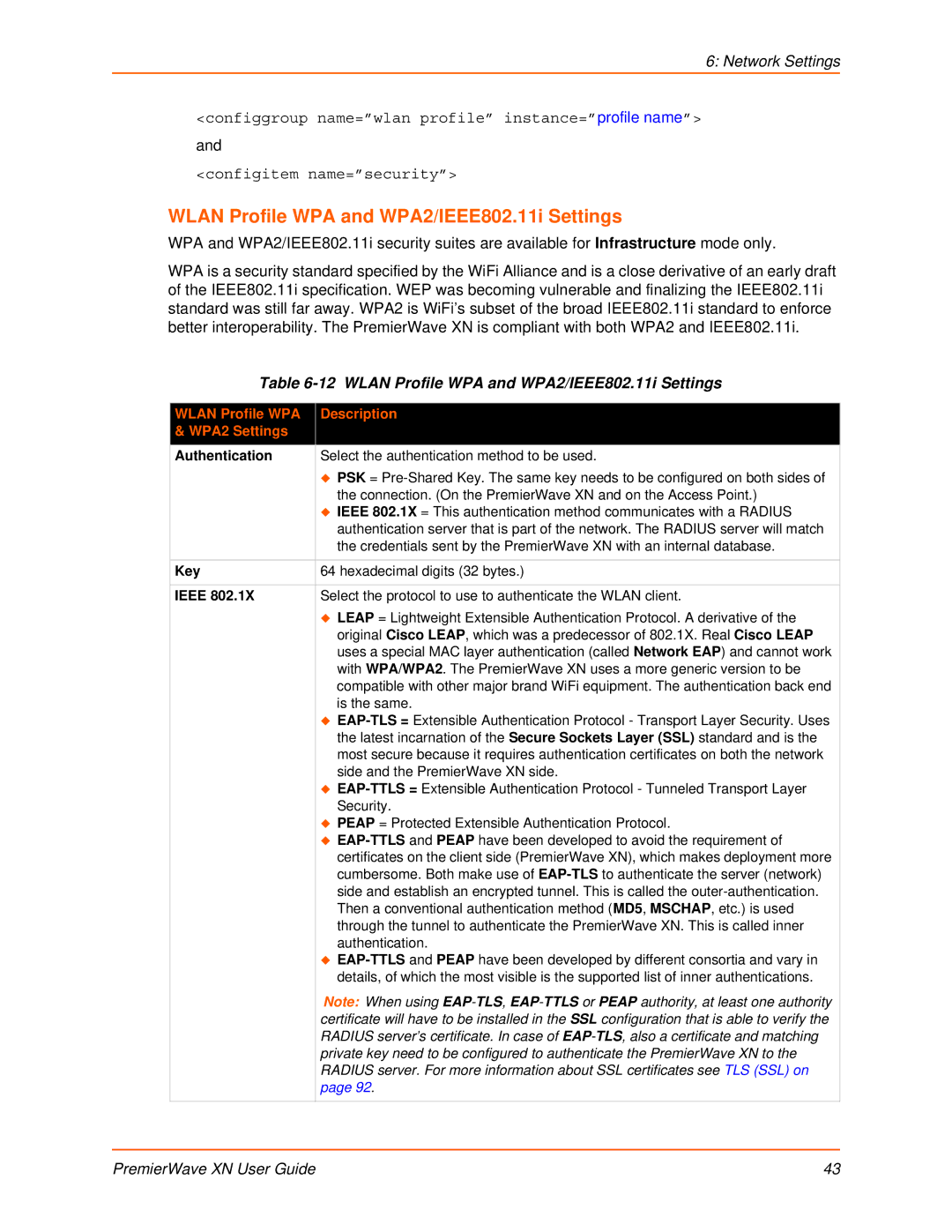
6: Network Settings
<configgroup name=”wlan profile” instance=”profile name”>
and
<configitem name=”security”>
WLAN Profile WPA and WPA2/IEEE802.11i Settings
WPA and WPA2/IEEE802.11i security suites are available for Infrastructure mode only.
WPA is a security standard specified by the WiFi Alliance and is a close derivative of an early draft of the IEEE802.11i specification. WEP was becoming vulnerable and finalizing the IEEE802.11i standard was still far away. WPA2 is WiFi’s subset of the broad IEEE802.11i standard to enforce better interoperability. The PremierWave XN is compliant with both WPA2 and IEEE802.11i.
Table 6-12 WLAN Profile WPA and WPA2/IEEE802.11i Settings
WLAN Profile WPA | Description |
& WPA2 Settings |
|
Authentication | Select the authentication method to be used. |
| PSK = |
| the connection. (On the PremierWave XN and on the Access Point.) |
| IEEE 802.1X = This authentication method communicates with a RADIUS |
| authentication server that is part of the network. The RADIUS server will match |
| the credentials sent by the PremierWave XN with an internal database. |
|
|
Key | 64 hexadecimal digits (32 bytes.) |
|
|
IEEE 802.1X | Select the protocol to use to authenticate the WLAN client. |
| LEAP = Lightweight Extensible Authentication Protocol. A derivative of the |
| original Cisco LEAP, which was a predecessor of 802.1X. Real Cisco LEAP |
| uses a special MAC layer authentication (called Network EAP) and cannot work |
| with WPA/WPA2. The PremierWave XN uses a more generic version to be |
| compatible with other major brand WiFi equipment. The authentication back end |
| is the same. |
| |
| the latest incarnation of the Secure Sockets Layer (SSL) standard and is the |
| most secure because it requires authentication certificates on both the network |
| side and the PremierWave XN side. |
| |
| Security. |
| PEAP = Protected Extensible Authentication Protocol. |
| |
| certificates on the client side (PremierWave XN), which makes deployment more |
| cumbersome. Both make use of |
| side and establish an encrypted tunnel. This is called the |
| Then a conventional authentication method (MD5, MSCHAP, etc.) is used |
| through the tunnel to authenticate the PremierWave XN. This is called inner |
| authentication. |
| |
| details, of which the most visible is the supported list of inner authentications. |
| Note: When using |
| certificate will have to be installed in the SSL configuration that is able to verify the |
| RADIUS server’s certificate. In case of |
| private key need to be configured to authenticate the PremierWave XN to the |
| RADIUS server. For more information about SSL certificates see TLS (SSL) on |
| page 92. |
|
|
PremierWave XN User Guide | 43 |
